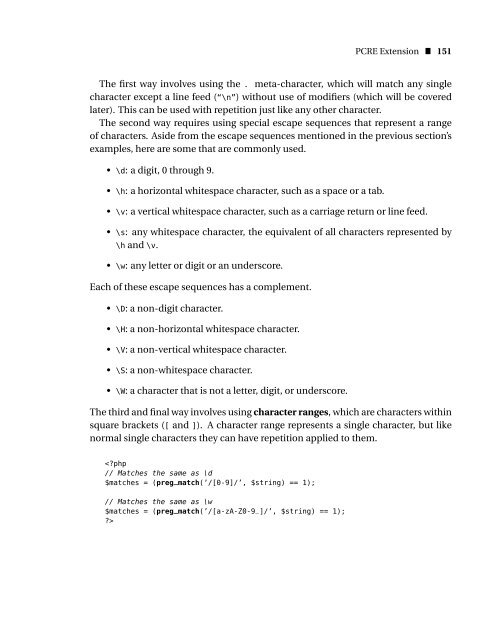php|architect's Guide to Web Scraping with PHP - Wind Business ...
php|architect's Guide to Web Scraping with PHP - Wind Business ...
php|architect's Guide to Web Scraping with PHP - Wind Business ...
You also want an ePaper? Increase the reach of your titles
YUMPU automatically turns print PDFs into web optimized ePapers that Google loves.
PCRE Extension ” 151<br />
The first way involves using the . meta-character, which will match any single<br />
character except a line feed (“\n”) <strong>with</strong>out use of modifiers (which will be covered<br />
later). This can be used <strong>with</strong> repetition just like any other character.<br />
The second way requires using special escape sequences that represent a range<br />
of characters. Aside from the escape sequences mentioned in the previous section’s<br />
examples, here are some that are commonly used.<br />
• \d: a digit, 0 through 9.<br />
• \h: a horizontal whitespace character, such as a space or a tab.<br />
• \v: a vertical whitespace character, such as a carriage return or line feed.<br />
• \s: any whitespace character, the equivalent of all characters represented by<br />
\h and \v.<br />
• \w: any letter or digit or an underscore.<br />
Each of these escape sequences has a complement.<br />
• \D: a non-digit character.<br />
• \H: a non-horizontal whitespace character.<br />
• \V: a non-vertical whitespace character.<br />
• \S: a non-whitespace character.<br />
• \W: a character that is not a letter, digit, or underscore.<br />
The third and final way involves using character ranges, which are characters <strong>with</strong>in<br />
square brackets ([ and ]). A character range represents a single character, but like<br />
normal single characters they can have repetition applied <strong>to</strong> them.<br />


